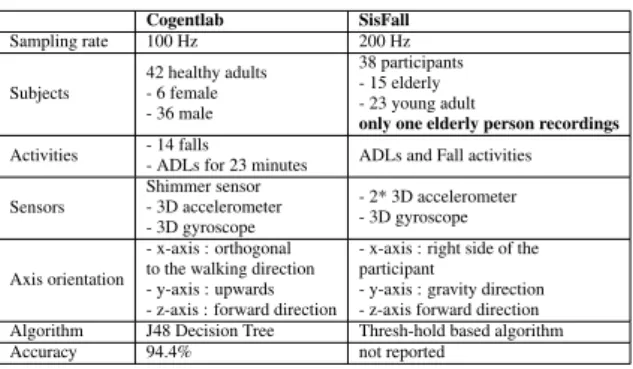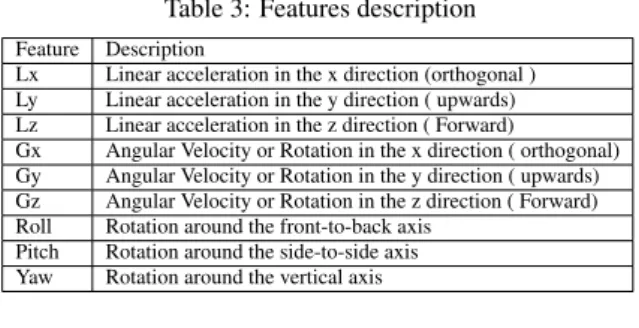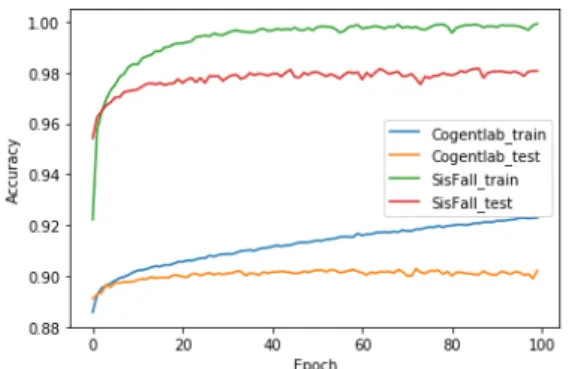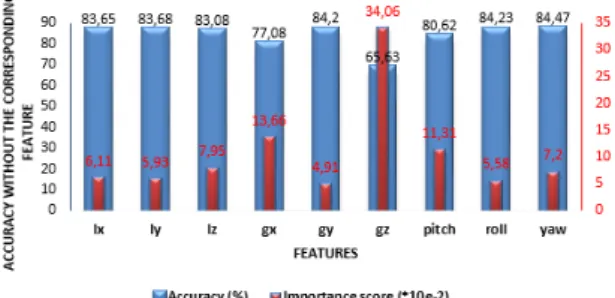HAL Id: hal-02931337
https://hal.archives-ouvertes.fr/hal-02931337
Submitted on 9 Sep 2020
HAL is a multi-disciplinary open access
archive for the deposit and dissemination of
sci-entific research documents, whether they are
pub-lished or not. The documents may come from
teaching and research institutions in France or
abroad, or from public or private research centers.
L’archive ouverte pluridisciplinaire HAL, est
destinée au dépôt et à la diffusion de documents
scientifiques de niveau recherche, publiés ou non,
émanant des établissements d’enseignement et de
recherche français ou étrangers, des laboratoires
publics ou privés.
Imbalance Prediction Among Elderly People Using Deep
Learning
Oussema Fakhfakh, Imen Megdiche, Réjane Dalce, Thierry Val
To cite this version:
Oussema Fakhfakh, Imen Megdiche, Réjane Dalce, Thierry Val. Imbalance Prediction Among Elderly
People Using Deep Learning. 17th ACS/IEEE International Conference on Computer Systems and
Applications AICCSA 2020, HOPE, Nov 2020, Antalya, Turkey. �hal-02931337�
Imbalance Prediction Among Elderly People Using Deep Learning
Oussema Fakhfakh
1, Imen Megdiche
1Γ
, Rejane Dalce
1and Thierry Val
2Γ
1Institut de Recherche en Informatique de Toulouse, Institut National Universitaire Champollion, ISIS Castres, France 2Institut de Recherche en Informatique de Toulouse, Universit´e Toulouse 2 Jean Jaur`es, France
{oussema.fakhfakh, imen.megdiche, rejane.dalce, thierry.val}@irit.fr
Keywords: Imbalance Prediction, Sensors, Deep Learning, Strong/Weak Signals, Eldery People
Abstract: As the elderly demographic grows larger, the need for efficient healthcare becomes pressing. One solution is to introduce Artificial Intelligence in the healthcare domain, which implies relevant dataset exploitation. In this paper, we address the issue of imbalance prediction using open-access sensor-based datasets recorded on both young adults and senior citizens. We highlight the need to adapt feature selection according to the population age : strong signals for one population may be classified as weak for another. Although the obtained results are encouraging, there remains a need for adaptive models developed using AI and under the guidance of medical experts.
1
INTRODUCTION
The growing number of elderly people and particu-larly in developed countries rises health challenges. As the state of elderly people can rapidly decline from robust to frail to dependant, the need for smart moni-toring systems endowed with artificial intelligence be-comes pressing.
Developing artificial intelligence based on the data generated from Iot devices is challenging in the case of elderly people studies: (i) first, gathering data is restricted for various reasons (medical, ethical...). So far, we found only one dataset (Sisfall) (Sucerquia et al., 2017) registering falls concerning one elderly person, (ii) second, deep learning or machine learning needs a huge amount of labelled data to train efficient models. If we consider fall or imbalance problems their observation rate for elderly people would not be sufficient. That’s why we found datasets (Kessentini et al., 2018)(Ojetola et al., 2015) generated by young participants imitating elderly problems.
Based on these facts, we propose in this paper an experimental study that investigates the cross evalu-ation of deep learning models generated on datasets observed on elderly and young people. The aim of this study is to highlight alternative methods to develop deep learning approaches combining both young and elderly observations. The topic of our in-terest is imbalance prediction as it is less addressed in the literature compared to fall and this degradation in the gait occurs before fall.
The remainder of this paper is organized as fol-lows : after reviewing the existing studies on fall and imbalance detection, we introduce our experimental settings, the datasets and the model architecture. We then present the obtained results and conclude the pa-per with a brief discussion and future work.
2
RELATED WORK
Imbalance prediction for elderly people is a topic re-lated to the preservation of autonomy. This topic is much less studied in the literature compared to fall detection. Considering the correlation between im-balance and fall, we present in this section the most relevant studies related to our proposition. We sum-marize in table 1 related work on either fall or im-balance with a particular focus on the devices used, the data mining algorithm employed and the possible preprocessing techniques.
Concerning fall detection systems, we can dis-tinguish three types of approaches : Camera-based, sensor-based and hybrid approaches. As for camera-based approaches, these solutions generate images data that can be analysed for movement tracking. The principal drawbacks of these solutions are :(i) the re-strictive rules to the subject movement, (ii) the need for a well equipped environment along with cameras and dedicated storage. This environment is predomi-nately indoor in elderly people houses. For this cate-gory, we cite the work of (Adhikari et al., 2017) which
uses a Kinect to track subject’s movement and im-plements a convolutional network in order to process captured images and classify human activities.
As for sensor-based approaches, we cite the work of (Casilari et al., 2017) who propose a star topology composed of a smartphone and SensorTags to record motion data. The smartphone acts as a central node and also produces acceleration data. The SensorTags placed on the ankle, waist, right wrist and chest of the subject, generate data through a 3D gyroscope and a 3D magnetometer. The work of (Sucerquia et al., 2017) also includes an accelerometer and a gyroscope mounted in the belt buckle. The collected data are available in the dataset SisFall1.The authors of (Musci et al., 2018) used SisFall to classify human activi-ties into three categories : fall, near fall and ADLs using a Long Short Term Memory architecture and achieved an accuracy of 97%. The authors of (Mah-fuz et al., 2018) used both SisFall and another open source dataset called ’MobiAct’. They achieved an accuracy of 98.75% in ADLs and falls classification task using a deep neural network. The authors per-formed preprocessing on the raw data of SisFall and MobiAct as well as new features generation.
Regarding accessory-mounted sensors, the work of (Huang et al., 2008) uses a smart cane that con-tains force sensors and a CCD camera. A two-state finite state machine has been implemented containing ’Normal walking mode’ and ’Falling down mode’. In this work, the distance between the center of legs and the cane was investigated in order to classify the sub-ject’s activity. The work of (Kessentini et al., 2018) presents a system that contains a smart cane connect-ing to ChisteraPi gateway. In this study, a dataset was created by letting young adult subjects experi-ence some ADLs and falls. They developed a K-Nearest Neighbors classifier achieving 97% accuracy. Hybrid approaches mix data obtained by cameras and sensors. The work presented by (Kwolek and Kepski, 2014) uses a wearable device mounted near the pelvis, containing a 3D accelerometer and a 3D gyroscope, and a smart Kinect camera. Data gener-ated are used in a threshold based algorithm to detect fall then compared with the results of an SVM model (99.67% of accuracy).
To conclude this section, we noticed that pa-pers focusing on fall detection consider activities like Stumbling or Near Fall, besides Forward Fall, back-ward Fall and lateral Fall while others consider these activities as ADLs. Compared to these works, we will focus on the non-fall state and investigate the ADLs related to imbalance (or as said near fall) states in
or-1http://sistemic.udea.edu.co/en/ investigacion/proyectos/english-falls/
Table 1: Summary on related work
Approach Connected device Algorithm Preprocessing (Chen et al., 2015) Smartphone enabled3D Accelerometer Finite statemachine No (Roeing et al., 2017)
Cell phone that contains invasive sensors
not reported No (Mahfuz et al., 2018) Smartphone Deep neural
network Yes (Fontecha et al., 2013) 3D accelerometer Affinity Tree Yes (Musci et al., 2018) 3D accelerometer/
3D gyroscope
Long Short Term Memory No (Sucerquia et al., 2017) 2*3D accelerometer/
3D gyroscope
Threshhold based classification
algorithm
Yes (Huang et al., 2008) Smart Cane Finite State
machine No (Casilari et al., 2017) 3D accelerometer/ 3D gyroscope/ 3D magnetometer not reported No (Kwolek and Kepski, 2014) 3D accelerometer/
3D gyroscope
Support Vector machine Yes (Kessentini et al., 2018) Cane/Teensy 3.2/
Lora Receiver
K-Nearest
Neighbors No
der to establish predictive models and study their rel-evance.
3
DEEP LEARNING FOR
IMBALANCE PREDICTION
In this section we present the datasets used, the data preprocessing performed on them and the architecture of the ANN network applied on our study.
3.1
Datasets
We identified two datasets for imbalance prediction. These datasets, Sisfall (Sucerquia et al., 2017) and Cogentlab (Ojetola et al., 2015), record falls and ADL activities.
Table 2 compares both datasets. Sisfall is ob-served on eldery people, while Cogentlab is obob-served on young people so that we can study the stability of imbalance model, the relevance of features as well as the cross evaluation between models. Table 3 lists the features in each dataset with their explanations. Given these common criteria, it is easy to compare results of these datasets.
Table 2: Sisfall vs Cogentlab comparison
Cogentlab SisFall Sampling rate 100 Hz 200 Hz Subjects 42 healthy adults - 6 female - 36 male 38 participants - 15 elderly - 23 young adult
only one elderly person recordings Activities - 14 falls
- ADLs for 23 minutes ADLs and Fall activities Sensors Shimmer sensor - 3D accelerometer - 3D gyroscope - 2* 3D accelerometer - 3D gyroscope Axis orientation - x-axis : orthogonal to the walking direction - y-axis : upwards - z-axis : forward direction
- x-axis : right side of the participant
- y-axis : gravity direction - z-axis forward direction Algorithm J48 Decision Tree Thresh-hold based algorithm
Table 3: Features description Feature Description
Lx Linear acceleration in the x direction (orthogonal ) Ly Linear acceleration in the y direction ( upwards) Lz Linear acceleration in the z direction ( Forward)
Gx Angular Velocity or Rotation in the x direction ( orthogonal) Gy Angular Velocity or Rotation in the y direction ( upwards) Gz Angular Velocity or Rotation in the z direction ( Forward) Roll Rotation around the front-to-back axis
Pitch Rotation around the side-to-side axis Yaw Rotation around the vertical axis
3.2
Data Preprocessing
In order to prepare our datasets for deep learning tasks, we perform these preprocessing steps :
• Features computation;
• Target column extraction to obtain a binary clas-sification problem (Imbalance / Not Imbalance); • Feature scaling to get normalized data.
3.2.1 Features Computation
We note that for the Sisfall the acceleration and rota-tion features are originally in bits. To convert them into gravity, as suggested by the authors of Sisfall2, we use the following equations:
Acceleration[g] : 2 ∗ Range
2Resolution∗ AccelBin (1) AngularVelocity[◦/s] :2 ∗ Range
2Resolution∗ RotationBin (2) For both SisFall and Cogentlab datasets, we computed the orientation data : pitch, roll, yaw using he formu-las cited in (Lachtar et al., 2019).
3.2.2 Target Extraction
CogentLab For imbalance state, we took the records corresponding to the Near-fall activity (”loss imbalance” label) and extract rows annotated by the normal walking. The resulting dataset for our study contains 313503 rows including 211866 correspond-ing to the normal walkcorrespond-ing state and 101637 corre-sponding to the imbalance case.
Sisfall We took data that corresponds to the label (Stumbling while walking) recorded for the 60-year old subject. We extracted also rows corresponding to the label (normal walking) recorded by the same subject. The resulting dataset for our study contains 31999 rows including 19999 corresponding to the normal walking state and 12000 corresponding to the imbalance case.
2http://sistemic.udea.edu.co/wp-content/ uploads/2015/11/Readme1.txt.
3.2.3 Feature Scaling
For our datasets, we investigate two types of scaling features standardization and Min-Max scaling. For standardization we used this formula :
z=x− v
s (3)
Where z represents the modified value, v indicates the variance of the feature x and s designates its standard deviation.
For Min-Max scaling, we used this formula : X norm= X− Xmin
X max− Xmin (4) Where Xnorm represents the obtained value after per-forming scaling, Xmin indicates the minimum value of the feature X and Xmax designates its maximum value.
Experimentations show that standardization is more suitable and efficient than Min-Max scaling based on the accuracy obtained in these two cases.
3.3
The ANN Model Architecture
In this paper, we implemented a fully connected neu-ral network based on following architecture:Figure 1: ANN architecture
• The input layer has 9 input units corresponding to the features of Table 3
• The first hidden layer contains 512 neurons and uses the ReLu activation function,
• The second hidden layer contains 128 neurons and also uses the ReLu activation function,
• The output layer for the binary classification uses the softmax activation function.
The choice of the different tuning parameters is done heuristically. First, we have investigated both the ReLu and Tanh functions for the hidden layers. The model with ReLu gave better results than the
one which used Tanh in particular with the Cogent-lab dataset. This dataset being the largest, we retain the ReLu function.
Concerning the number of neurons (units) which are generally a power of 2, we tried all possible com-binations in the interval [32 − 512]. Simulations show that 512 for the first hidden layer and 128 for the sec-ond one give the best results.
Finally, for the final activation function used in the output layer, we experiment both sigmoid and soft-max for our binary classification problem. Simula-tions showed that Softmax is more precise than sig-moid in term of correct predictions.
4
EVALUATION RESULTS
The aim of our evaluations is twofold: (1) check the relevance of deep learning approaches for predicting imbalance based on sensor’s data , (2) demonstrate experimentally that there is a subtlety between weak signals and strong signals for the prediction of im-balance that should be considered when constructing deep learning models. The first objective is presented in the subsection 4.1. The second objective is ad-dressed in subsections 4.2 and 4.3.
We note that the evaluation results presented in this section were produced on a computer with an Intel core i5 CPU and a 8 GB memory. The code source was developed on the Anaconda plat-form with the python 3.7 version. Several libraries were employed such as numpy, pandas, matplotlib, seaborn, tqdm, sklearn for data preparation, keras for deep learning and eli5 for feature importance de-termination.
4.1
Model Evaluation
Based on the architecture presented in previous sec-tion, we carried out two evaluations on SisFall and CogentLab data sets. These evaluations followed the same experimental settings : (i) 100 epochs, (ii) 64 batch size, (iii) the Adam implementation for the gra-dient descent algorithm, (iv) the categorical crossen-tropy for the loss function and (v) 33% for test set , 67% for train test.
As shown in Figure 2, we can observe the evolu-tion of the Accuracy both on the train (green and blue curves) and test (orange and red curves) sets through the 100 epochs. The accuracy of our model applied on these datasets for the train exceeds 90% which is a very interesting result. We can notice, for the Co-gentlab dataset, that the model starts overfitting on the train set after the 30 th epoch. This can be explained
by the volume of this dataset compared to the Sisfall dataset. But we highlight that we have a stability on the test set so this overfitting problem can be fixed by a good tuning of the number of epochs. In this exam-ple, 40 epochs are sufficient to get a stable and good model for both datasets.
Figure 2: Model accuracy evolution through 100 epochs
4.2
Feature Importance Determination
Discovering the most important characteristic(s) in our study will lead to determining the most suitable sensors for elderly people monitoring. To evaluate the feature importance, we use the eli53library. The con-cept is to eliminate one feature at a time, run the train-ing process and compute the accuracy of the model. The most significant feature is the one which absence most degrades the accuracy score. A second comple-mentary alternative consists in observing the weights of each feature according to the model by running it with all the features.Features observations for Cogentlab and Sisfall Regarding the Cogentlab dataset, Figure 3 summa-rizes the importance and the weights of the different features. These figures show that the angular velocity features generated by the 3D gyroscope, along the x and z axes, and the pitch are the most influential fea-tures in imbalance prediction. These observations are similarly coherent with the work of (Lachtar et al., 2019). Regarding Sisfall, we see in Figure 4 that the most important features are the linear acceleration data obtained by the 3D accelerometer.
Discussion. We observe a significant difference in the prioritization of the features between Cogentlab and Sisall. Therefore, we can make the following assumption : elderly people movement is affected the most by the linear acceleration while young adult
3https://eli5.readthedocs.io/en/latest/ overview.html
Figure 3: Features importance for Cogentlab
Figure 4: Features importance for SisFall
movement is influenced the most by the angular ve-locity. This means that the observation of imbalance with sensors gives off two types of signals :
• The strong signals are the most important features for the elderly people using sensors. These signals are close to the state of fall or in advanced stages of imbalance,
• The weak signals are the most influential features for the young adult movement which are in the same time among the least significant features for the elderly people movement. These signals can be observed for the starting stages of the imbal-ance problems.
So for elderly people with advanced state imbal-ance, the prediction models will be efficient with strong signals. But for eldery people on the starting stages of imbalance or in the middle stages, we should think on new strategies of constructing the prediction models.
4.3
A Cross Evaluation Of Models
In this section, we study the impact of weak and strong signals on the quality of predictions on both datasets. We proceed by a cross evaluation of models. We use three settings: (1) Setting 1 consists in apply-ing the prepared ANN on each complete data set sep-arately, then saving each model and applying a cross evaluation of models, (2) Setting 2 consists in usingonly weak signals as features (which are in our case rotation and pitch data) and applying a cross evalu-ation of models, (3) Setting 3 consists in using only strong signals as features (which are in our case accel-eration and pitch data) and applying a cross evaluation of models. For all these settings, let model1 refer to the ANN trained on SisFall, while model2 refers to the ANN trained on Cogentlab.
Setting 1 observations As shown in Table 4, when we evaluate Cogentlab using model1 we get an accuracy of 47%, whereas, the application of model2 on Sisfall gives an accuracy of 57%. We have an important decrease compared to the application of each model on its dataset. Therefore, it’s clear that our models with both weak and strong signals aren’t stable. These results suggest that a composite process of evaluation taking advantage of both signals separately would be better.
Table 4: Setting 1 results
SisFall Model Cogentlab Model
SisFall 98% 57%
Cogentlab 47% 90%
Setting 2 observations As shown in Table 5, when applying model 1 in SisFall using only weak signals, we get an accuracy of 84%. We note a decrease in accuracy from 98% to 84% by using weak signals. In contrast, evaluating model2 in Cogentlab data set us-ing only weak signals gives us an accuracy of 88%. When applying model1 in Cogentlab we get an ac-curacy of 60%, while the evaluation of SisFall us-ing model2 gives us 72%. These results confirm the relevance of weak signals in the imbalance detection when observed individually.
Table 5: Setting 2 results
SisFall Model Cogentlab Model
SisFall 84% 72%
Cogentlab 60% 88%
Setting 3 observations As shown in Table 6 for Co-gentlab data set, we evaluated it using model2 and we get an accuracy of 76%. The decrease from 90% to 76% can be explained by the absence of the most significant features in the prediction of imbalance for the young adult subjects present in Cogentlab. For the model stability verification in this context, we ap-plied model1 in Cogentlab which gave us a score of
51% while trying model2 in SisFall returned a score of 33%.
Table 6: Setting 3 results
SisFall Model Cogentlab Model
SisFall 89% 33%
Cogentlab 51% 76%
We observe from these results a potential com-plementarity in prediction between the weak signals model, applied on young adult subjects and the strong signals models, applied on elderly subjects. The re-sults suggest that a twofold model would perform bet-ter in this case: by following a composite process, the model based on the weak signals would produce cor-rect predictions in situations where the strong signals model would fail and vice versa.
5
CONCLUSION
In this paper we presented an experimental study to showcase new hypothesis related to imbalance pre-diction for elderly populations. Thanks to an artifi-cial neural network applied on Congentlab and SisFall datasets and a cross evaluations of models, we ob-served a complementarity between weak and strong signals. Our results are encouraging but should be validated by medical experts and tested on larger pop-ulations. For future work, we develop new strategy of deep learning compositions in the light of weak and strong signals. It will be validated on a new collected scalable dataset based on a smart stick. The Iot device is connected with three communication technologies LoRa, BLE and WiFi. We plan to collect data for both young and eldery peoples on nursing residences.
REFERENCES
Adhikari, K., Bouchachia, H., and Nait-Charif, H. (2017). Activity recognition for indoor fall de-tection using convolutional neural network. In 2017 Fifteenth IAPR International Conference on Machine Vision Applications (MVA), pages 81–84.
Casilari, E., Santoyo-Ram´on, J. A., and Cano-Garc´ıa, J. M. (2017). Umafall: A multisensor dataset for the research on automatic fall detection. Proce-dia Computer Science, 110:32–39.
Chen, P.-H., Li, Y.-H., Chiou, C. W., Lee, C.-Y., and Lin, J.-M. (2015). A smart safety cane for human fall detection. International Journal of Ad Hoc and Ubiquitous Computing, 20(1):49–65.
Fontecha, J., Navarro, F. J., Herv´as, R., and Bravo, J. (2013). Elderly frailty detection by using accelerometer-enabled smartphones and clinical information records. Personal and ubiquitous computing, 17(6):1073–1083.
Huang, J., Di, P., Wakita, K., Fukuda, T., and Sekiyama, K. (2008). Study of fall detection using intelligent cane based on sensor fusion. In 2008 International Symposium on Micro-NanoMechatronics and Human Science, pages 495–500. IEEE.
Kessentini, O., Dalce, R., Megdiche, I., and Bastide, R. (2018). Towards predicting frailty symp-toms through a smart walking stick. In 2018 IFIP/IEEE International Conference on Perfor-mance Evaluation and Modeling in Wired and Wireless Networks (PEMWN), pages 1–7. Kwolek, B. and Kepski, M. (2014). Human fall
de-tection on embedded platform using depth maps and wireless accelerometer. Computer methods and programs in biomedicine, 117(3):489–501. Lachtar, A., Val, T., and Kachouri, A. (2019). Elderly
monitoring system in a smart city environment using LoRa and MQTT. IET Wireless Sensor Systems, 2043-6386:(on line).
Mahfuz, S., Isah, H., Zulkernine, F., and Nicholls, P. (2018). Detecting irregular patterns in iot streaming data for fall detection. In 2018 IEEE 9th Annual Information Technology, Electronics and Mobile Communication Conference (IEM-CON), pages 588–594. IEEE.
Musci, M., De Martini, D., Blago, N., Facchinetti, T., and Piastra, M. (2018). Online fall detection using recurrent neural networks. arXiv:1804.04976.
Ojetola, O., Gaura, E., and Brusey, J. (2015). Data set for fall events and daily activities from inertial sensors.
Roeing, K. L., Hsieh, K. L., and Sosnoff, J. J. (2017). A systematic review of balance and fall risk assessments with mobile phone technology. Archives of gerontology and geriatrics, 73:222– 226.
Sucerquia, A., L´opez, J. D., and Vargas-Bonilla, J. F. (2017). Sisfall: A fall and movement dataset. Sensors, 17(1):198.



